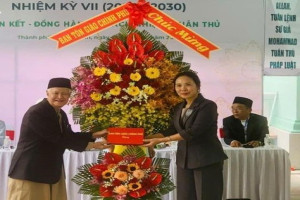
A recent study conducted by the Pew Research Center ranked Vietnam as the third most religiously diverse country in the world, behind only Singapore and Taiwan.
This study, using 2010 data, calculates Religious Diversity Index (RDI) scores of countries and territories based on the shares of eight major religious categories: Buddhism, Christianity, Hindu, folk religions, Islam, Judaism, religious groups and the religiously unaffiliated. The index is on a scale from 0-10, with 10 being maximum possible diversity if each of the eight religious categories constitutes an equal share the population. The RDI is divided into four ranges: very high (scoring from 7 to 10 point), high (scoring from 5.3 to 6.9), moderate (scoring from 3.1 to 5.2) and low (scoring from 3.1 down to zero).
The measured RDI of 232 countries and territories in this study show that 12 countries have a very high degree of religious diversity. Six of the 12 are in the Asia-Pacific region, including Singapore, Taiwan, Vietnam, South Korea, China and Hong Kong.
Vietnam scores 7.7 point in this calculating scale, while Singapore gets the highest score of 9.0 and Taiwan receives the second highest score of 8.2.
The result of this study on Vietnam practically reflects current religious landscape in Vietnam where the Vietnam State have officially recognized dozens of religious organizations belonging Catholicism, Protestantism, Buddhism, Muslim, Hindu, Baha’i and a large number of folk religions (Caodaism, Minh Su religion, Minh Ly religion, Buu Son Ky Huong, Tu An Hieu Nghia…). Beside these recognized religious organizations, there are many other religious groups, such as Phap tang Phat giao Vietnam (Vietnam Buddhist Dharma Association), Nhat Quan Dao (I-Kuan Tao), To Tien Chinh giao (Orthodox Ancestral Faith) and other Christian denominations (Jehovah’ Witnesses, Methodist…), whose religious activities have been mainly conducted at home or registered places.
A high degree of religious diversity in Vietnam also demonstrates due respect and tolerance for religious freedom and equality by the people and State of Vietnam. Since the Ordinance on Belief and Religion was promulgated by the Standing Committee of the National Assembly in 2004, the number of religious organizations recognized by the State has increased from 16 in 2004 to current number of 38, and an addition of over 30 religious groups operating locally has been recognized by local governments. The current number of followers of religions and religious groups in the country is about 24 million, in comparison to 10 million in 1975. Protestantism, often regarded as the fastest growing religion in Vietnam, has increased from some 200,000 adherents in 1975 to about 1.5 million in 2013.
It’s interesting that, as indicated by the result of this global religious diversity study, non of the countries including Australia, Canada, the US and European countries fall into the range of 12 countries and territories having a very high degree of religious diversity, although these countries have a very high level of diversity in term of the traditionally well-know religions (such as Buddhism, Christianity, Hindu, Islam and Judaism) and many newly formed religious groups. This is due to the fact that the calculation in this study took into account ratio of followers of each of the eight religious categories over the country population and the inclusion of folk religions as one of the eight major categories in each country. And, it’s obvious that most of the above-mentioned countries have Christian majorities and do not have a high percentage of followers of folk religions as relatively compared to the 12 countries scoring a very high degree of religious diversity index.
The study of global religious diversity conducted by the Pew Research Center is a follow-up of an ambitious project for analyses of religious change and its impact on societies around the world which produced estimates of the religious makeup of more than 200 countries and territories and published these estimates in the 2012 report “The Global Religious Landscape.”

Tri An




